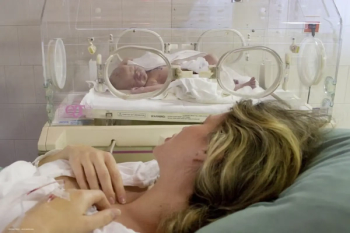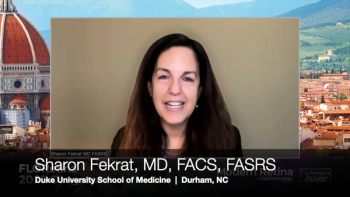
- Ophthalmology Times Europe January/February 2025
- Volume 21
- Issue 1
- Pages: 24 - 26
Crafting an international database for retinopathy of prematurity
Intercontinental collaboration is key to unlocking ROP in our lifetime
Though retinopathy of prematurity (ROP) is a rare disease, its effects can be devastating for patients. In an effort to better understand this lifelong condition and the associated vision loss, an international team set out to create a joint set of database parameters. Those parameters were the basis for the European registry on retinopathy of prematurity (EU-ROP) and Fight Childhood Blindness! ROP Registry.
Together, an international working group developed a set of parameters which are minimal enough that they are easy to collect in a clinical setting, but comprehensive enough to help physicians worldwide gain a better understanding of ROP (Table). Those parameters include details such as patient demographics, systemic comorbidities, ROP status, treatment details, ophthalmic and systemic complications of treatment, ophthalmic and neurodevelopmental outcomes at initial treatment, and any episodes of retreatment and data collected at follow-up examinations, in both the short and long-term.
To learn more, Ophthalmology Times Europe spoke to Caroline Catt, MB, BS, FRANZCO, who is based in Australia. She is a consultant ophthalmologist at the Children’s Hospital Westmead, in Westmead, at Liverpool Hospital in Liverpool, and at the Royal North Shore Hospital (NICU), Sydney. She is chair of the Australian and New Zealand Paediatric Ophthalmology Society.
Dr Catt was part of the core working group on the EU-ROP and Fight Childhood Blindness! ROP registries, alongside Daniel Barthelmes, MD, PhD, of the University Hospital Zürich, Zürich, Switzerland; Andreas Stahl, MD; and Johanna M. Pfeil, both of the University Medicine Greifswald, Greifswald, Mecklenburg-Vorpommern, Germany.
Dr Catt described the process of developing the parameters alongside colleagues in other paediatric specialities, explained why global data collection is so vital to ROP research, and gave advice for clinicians putting the parameters into practice during research.
Hattie Hayes: The working group evolved as you amassed a dataset and fine-tuned the parameters for ROP management. How did the group expand and contract over time?
Caroline Catt, MB, BS, FRANZCO: The group started when Daniel Barthelmes put me in contact with Adreas Stahl, as he was aware we both had hopes to write and build an ROP registry. We three met via online teleconference during the early days of the COVID-19 pandemic and realised an international collaboration was not only possible, but preferable, and that our projects had synergies that would make them more powerful if we worked together on developing the dataset.
Along with Johanna M. Pfeil, we met weekly for many months to establish a first thorough draft of the dataset. We then sought additional international expertise to refine the dataset, also meeting by regular teleconferencing, and sought the opinion of neonatologists by written and spoken communication. We also had neonatologists review our proposed dataset. Finally, the dataset was reviewed by a group of experts from the Asia-Pacific [region], to refine it for use in our geographical area.
HH: What were the most impactful recommendations from contributors outside ophthalmology?
CC: We engaged the expertise of neonatologists at multiple points, including on an ad-hoc basis when we realised we needed their advice in order to progress our dataset accurately, and to advise us on our dataset once written in case we had any unknown blind spots. Our neonatology colleagues have been very supportive and generous with their time and expertise in this regard. Neonatologists were particularly helpful with their advice on the long-term neurodevelopmental outcomes and the neonatal systemic diagnosis that would be most helpful and discriminatory. For example, we originally had necrotising enterocolitis as a neonatal diagnosis but were soundly advised to separate [it] into necrotising enterocolitis requiring surgical management and necrotising enterocolitis not requiring surgical management in order to stratify the risk profile more appropriately.
HH: How did the team model the parameters in this project against existing databases?
CC: We used the German retina.net dataset as an initial framework. Interestingly, I did not have access to that dataset before our first meeting, but the structure and parameters I listed ahead of the meeting were very similar to it, suggesting it was an intuitive framework for anyone working as an ROP clinician. We did not look at existing datasets for other eye diseases, but we did use the Fight Retinal Blindness! Save Sight Registries approach of having a dataset that was ”minimal, patient centered and easy to collect in routine clinical practice.” We returned to these principles over and over again to help refine our dataset.
HH: There were some parameters that were included in EU-ROP or the Fight Childhood Blindness! ROP registries, but not both. Could you detail these differences? Were they regional in nature?
CC: This small number of changes came out of the recommendations of the final group of experts who refined the dataset for the Asia-Pacific context. For example, conbercept is used in China for the treatment of ROP. Conbercept and some other anti-VEGF agents are not used for ROP in other countries, whereas ranibizumab is widely used.
Additionally, we anticipated periventricular leukomalacia and porencephaly may be difficult to enter accurately by ROP clinicians, as it may not be routinely recorded as such in head ultrasound reports during the inpatient period.
Because we have an existing Australian and New Zealand Neonatal Network database which contains very extensive systemic data (and also includes data from several South-East Asian countries such as Singapore and Malaysia), and we can link the data in our database with that database via a patient identifier, we decided to remove some of the parameters from our dataset knowing it can be sought elsewhere if required. We all plan to keep the Fight Childhood Blindness! ROP and EU-ROP [registries] datasets very closely aligned so data can be combined in the future if needed.
The way children are followed-up in the long-term also differs by country and by jurisdiction so we anticipate there will be difficulties continuing data entry over the long-term in some cases. I think [additional regional differences] will reveal themselves once we analyse the registry data.
HH: Are there any parameters which were not included at the
conclusion of this project, but which you think could be included in a future set of parameters?
CC: In the interests of minimising the dataset, we have not asked specifically about persistent avascular retina (PAR), but instead assume it is present if the child is not vascularised into Zone 3 or receives laser treatment without type 1 ROP disease recurrence after previous anti-VEGF treatment. It is possible we may need to add PAR as a specific clinical diagnosis or indication for retreatment in future iterations of the parameters.
HH: What advice do you have for researchers to implement these parameters successfully?
CC: Having knowledge of the parameters ahead of recording your clinical data is helpful, as the ophthalmic parameters are almost always collected in routine clinical practice, the systemic parameters can be advised by the bedside nurse or neonatologist, and for the longer-term follow-up parameters, parents and carers will often be able to provide you with the correct information. Entering data in real time (as you see the patient) is also very helpful. It takes me about 15 seconds to enter a post-treatment follow-up visit on the Fight Childhood Blindness! ROP Registry platform. It is very quick. It takes me longer if I have to do it retrospectively.
HH: Have you received any feedback from your colleagues who have used these parameters since the findings were published?
CC: I have had a colleague suggest [that] a free-text box so the clinician can make notes would be helpful. Free text is something we have tried to avoid because it is difficult to analyse as data, but I understand the point that it can be helpful for the clinician, so we will look at this with the next iteration. Of course, we would be happy to hear any feedback so we can make future versions more user-friendly.
The other feedback I have had is from parents who can see their child’s ROP journey as a graph on the Fight Childhood Blindness! ROP platform. They love seeing the ROP score drop down and flatline in response to treatment.
HH: Why is it so important to have a specific ROP registry within the existing Fight Retinal Blindness! [project] framework?
CC: The study of ROP lends itself well to a registry format because the disease is relatively rare and its treatment has undergone a paradigm shift in our working memory. It is so important for us as clinicians to get the best outcomes for these patients who have their entire lives ahead of them.
So many questions about ROP treatment remain unanswered—what is the best drug, the right dose, the correct follow-up protocol, the best way to manage persistent avascular retina? Are there any neurodevelopmental sequelae from using an anti-VEGF agent in a premature child? It is very difficult, perhaps impossible, to answer these questions by undertaking randomised controlled trials. Real-world data, supplied via a real-world data registry such as the Fight Childhood Blindness! ROP and EU-ROP [registries], give us the best chance of answering these questions within our lifetimes.
Reference
1. Catt C, Pfeil JM, Barthelmes D, et al. Development of a joint set of database parameters for the EU-ROP and Fight Childhood Blindness! ROP Registries. Br J Ophthalmol. 2024;108(7):1030-1037. doi:10.1136/bjo-2023-323915
Caroline Catt, MB, BS, FRANZCO | E: [email protected]
Dr Catt is a paediatric and general ophthalmologist in Sydney, Australia. She is a consultant ophthalmologist at The Children's Hospital at Westmead, Royal North Shore Hospital and Liverpool Hospital NICU and is a Partner of Sydney Ophthalmic Specialists. She is the principal investigator of the Fight Childhood Blindness! ROP Registry (a Save Sight Registry), is Chair of the Australian and New Zealand Paediatric Ophthalmic Society and is a Clinical Senior Lecturer at The University of Sydney.
Articles in this issue
10 months ago
IOL design puts a new spin on vision10 months ago
Helping patients with glaucoma manage mental health10 months ago
Shifting the narrative around dry eye disease10 months ago
A new home treatment for amblyopiaNewsletter
Get the essential updates shaping the future of pharma manufacturing and compliance—subscribe today to Pharmaceutical Technology and never miss a breakthrough.













































